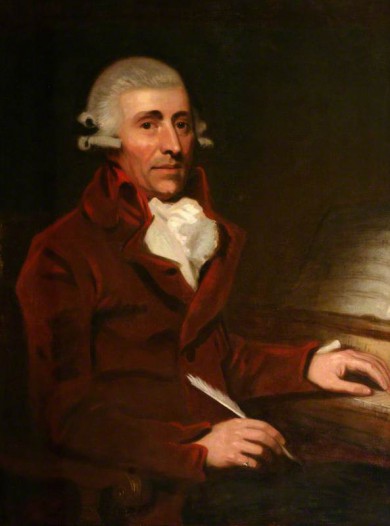New World chamber program mixes attractive Classical-era music with dispensable 1960s works

Franz Joseph Haydn’s Symphony No. 80 was performed by New World Symphony members Sunday afternoon. Painting by Mather Brown.
The order of works on the New World Symphony’s final chamber program of the year Sunday appeared designed to make some sort of point.
Each half of the concert opened with a thorny atonal composition from the 1960s, the golden age of academic modernism. Following these were works of Mozart and Haydn, two of history’s most direct, melodious and approachable composers. Whatever contrast the program was trying to make, it did not put the two Classical masters at a disadvantage.
The concert at New World Center in Miami Beach opened with the Wind Octet of Einojuhani Rautavaara, one of Finland’s most distinguished composers, who would return to tonality later in life. His 1962 Wind Octet, however, was composed in the 12-tone style favored by that era’s avant-garde.
But like other composers, such as Alban Berg, who softened the edges of the 12-tone system, he composed the work in a manner that left it with traces of tonality and stylistic remnants of music that had come before.
The flute, oboe and clarinet play quick, light figures. More sober tones came from the horns, trombone and occasionally the bassoon, which joined together to create solemn, choir-like passages. There were rich sonorities, which, if not 19th century, made some harmonic sense. But with an absence of recognizable melodies and the complexity of its musical language, this was a difficult work to grasp on first hearing.
Next came Mozart’s Piano Quartet No. 1 in G Minor, a piece rich in melodies, grace and excitement. The quartet puts the pianist at center stage, with a difficult, concerto-like part that dominates the work.
New World’s piano fellow, Dean Zhang, rose to the occasion with a masterly performance, fluid, graceful and with a natural feel for the arc of Mozart’s melodies. In his hands, the runs, arpeggios and ornamentations that accompanied melodies in the strings came off in a bright, easy manner, without any sign of effort, persuasive and well articulated.
Violinist Peiming Lin, violist Kurt Tseng and cellist Jennifer Choi played with impeccable precision and intonation. The performance sagged slightly toward the end of the opening Allegro, when the music turns dark and dramatic, and more forceful projection would have given the music the power it deserved.
From one look at the stage, it was obvious that Willow, Willow, a 1968 work by Paul Chihara, would be an unusual piece. Two sets of timpani stood at either side of the stage. At center stage sat Masha Popova, who would play amplified bass flute. Directly behind her sat tuba player Jarrett McCourt. At the back of the stage, sat another percussionist with a bass drum, gong and other instruments.
Willow, Willow is an austere work. The two timpani players engage in a dialogue. The flute plays a few notes. There were long-held notes in flute and tuba over a tinkling of notes on the chimes and xylophone. followed by a brief percussion riot. The flute returned, a percussionist made a hissing sound into a microphone, and then it was over. Like the opening work, this was hard to make sense of on first hearing, and gave every impression that multiple hearings may not wouldn’t make it any easier.
For the final work on the program, a chamber-sized orchestra took the stage, with everyone standing except for cellos and basses, to perform Haydn’s Symphony No. 80. Leading from the concertmaster position was a guest artist, violinist Alexander Kerr, concertmaster of the Dallas Symphony Orchestra.
The absence of a stand-alone conductor appeared to make no difference. This was a sizzling performance of one of those rare Haydn works in which the composer shows his darker, minor-key side.
From the start, when the orchestra launched into a nervous series of ascending notes, this was a hard-driving, crisply executed account, precise and with a thread of electricity running through the performance.
The Adagio was played with rounded, full tones, with the music swelling in a natural, unified manner. Inner voices, such as the busy notes of second violins and violas that accompanied the melody, emerged clearly without distorting the shape of the music. Flute and oboe played with particular grace and tonal warmth in the Trio.
The Finale came off with all of Haydn’s energy and humor, the wit of the rapid syncopated notes and whipcrack precision of the strings bringing the work to a spirited close.
Posted in Performances
Leave a Comment
Mon Dec 18, 2017
at 12:59 pm
No Comments






